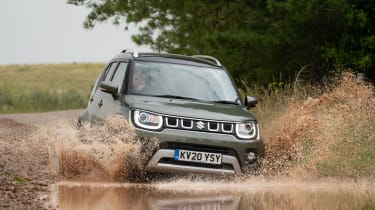Suzuki Ignis review - Engines, performance and drive
Keep the Ignis in town and it’s nippy and agile, but it starts to struggle on the open road

The Suzuki Ignis pretends to be a shrunken SUV, but it’s actually one of the lightest cars you can buy in Britain - base models weigh in at just 895kg, which is lighter than a two-seat Smart EQ fortwo coupe.
The Ignis feels agile and nimble as a result of that low weight and short wheelbase, meaning it's certainly a world away from most heavy crossovers. It’s a delight to drive around town, with the small size, upright driving position and excellent visibility making it perfect for threading through tight gaps.
However, it lacks the sophistication of rivals once you head out onto the open road, with slow and vague steering reducing the fun factor when speeds increase. Body roll is noticeable despite an initially keen feel, while a number of conventional city cars tackle bends with more composure.
The ride is also a bugbear. The Ignis is softly sprung, taking the edge off speed humps, but it gets caught out easily by sharp bumps, which thud and crash through the cabin. Road noise is quite pronounced, too, while noticeable wind and engine noise mean it isn’t the best city car for longer journeys.
A facelift in 2020 brought in an updated hybrid system, with a larger-capacity battery pack and a revised belt-driven starter-generator to improve efficiency. Suzuki also modified the 1.2-litre four-cylinder petrol engine, introducing a new fuel injection system, an updated variable valve timing system, a variable displacement oil pump and electric piston cooling jets.
Engines, 0-62mph acceleration and top speed
Your engine choice is limited if you want an Ignis. To keep costs down, Suzuki offers just an 82bhp 1.2-litre four-cylinder ‘Dualjet’ petrol engine, coupled with a mild-hybrid system for economy-minded buyers.
Around town there’s plenty of poke to get you about, with a slick gearshift letting you keep it on the boil. 107Nm of torque isn’t an awful lot, however, so on motorways and up hills you’ll need to rev it hard just to keep up with traffic. It’s noisy when you do so, too.
There's only a few tenths splitting the model range in terms of sprinting ability: the entry five-speed manual version manages 0-62mph in 12.7 seconds, with the CVT automatic a little quicker at 12.4 seconds. The all-wheel-drive SZ5 model is the slowest of the bunch, taking 12.8 seconds from to reach 0-62mph.









